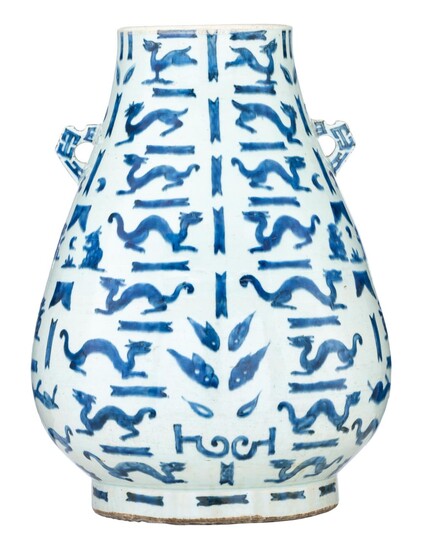An extremely rare Chinese blue and white archaistic hu vase, mid-Qing dynasty, H 48,2 cm
An extremely rare Chinese blue and white archaistic hu vase, mid-Qing dynasty, H 48,2 cm
A Chinese archaistic hu vase, blue and white decorated with a design inspired by archaic bronze vessels, painted with taotie masks around the body, surrounded by chilongs, stylised rabbits and deer, separated by broken lines, the neck paired with loop handles, the bottom with an unidentified text in archaistic Chinese, mid-Qing dynasty, H 48,2 cm
Of Hu/Zun form, characterised by its pear-shaped body, a shape borrowed from the Chinese archaic bronze vessels. This form was first developed under the reign of the Qing emperor Kangxi (1661-1722) and perfected during the reign of Emperor Qianlong (1735-1796). The playful blue and white design is reminiscent of the Transitional porcelain during the Shunzhi period (1644-1661).
Provenance: the property of a Belgian lady, acquired in the 1970s - 1980s.
A similar lot sold at Bonhams London from the notorious collection of Jacques and Galila Hollander.
As described by Bonhams, a near-identical vase, but with a six-character Kangxi mark, and of the period, is in the Palace Museum collection in Beijing. And according to the scholar Chen Runmin, these vases are extremely rare. See Qing Shunzhi Kangxi Chao Qinghua ci, Beijing, 2005, p. 473, pl. 304 (see fig.1).
Condition: The vase appears, in our opinion, overall in good condition, with no repairs:
- a shallow chip to one of the handles
- two spots with visible star-shaped crack to the lower tummy: both impacts were pierced through the inside and thus visible on the outside as well as the inside.
- two other spots with a star-shaped crack only visible to the inside.
Sale price
Estimate
Reserve
Time, Location
Auction House
An extremely rare Chinese blue and white archaistic hu vase, mid-Qing dynasty, H 48,2 cm
A Chinese archaistic hu vase, blue and white decorated with a design inspired by archaic bronze vessels, painted with taotie masks around the body, surrounded by chilongs, stylised rabbits and deer, separated by broken lines, the neck paired with loop handles, the bottom with an unidentified text in archaistic Chinese, mid-Qing dynasty, H 48,2 cm
Of Hu/Zun form, characterised by its pear-shaped body, a shape borrowed from the Chinese archaic bronze vessels. This form was first developed under the reign of the Qing emperor Kangxi (1661-1722) and perfected during the reign of Emperor Qianlong (1735-1796). The playful blue and white design is reminiscent of the Transitional porcelain during the Shunzhi period (1644-1661).
Provenance: the property of a Belgian lady, acquired in the 1970s - 1980s.
A similar lot sold at Bonhams London from the notorious collection of Jacques and Galila Hollander.
As described by Bonhams, a near-identical vase, but with a six-character Kangxi mark, and of the period, is in the Palace Museum collection in Beijing. And according to the scholar Chen Runmin, these vases are extremely rare. See Qing Shunzhi Kangxi Chao Qinghua ci, Beijing, 2005, p. 473, pl. 304 (see fig.1).
Condition: The vase appears, in our opinion, overall in good condition, with no repairs:
- a shallow chip to one of the handles
- two spots with visible star-shaped crack to the lower tummy: both impacts were pierced through the inside and thus visible on the outside as well as the inside.
- two other spots with a star-shaped crack only visible to the inside.



